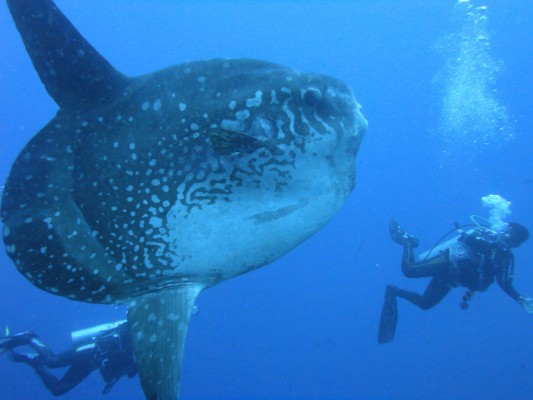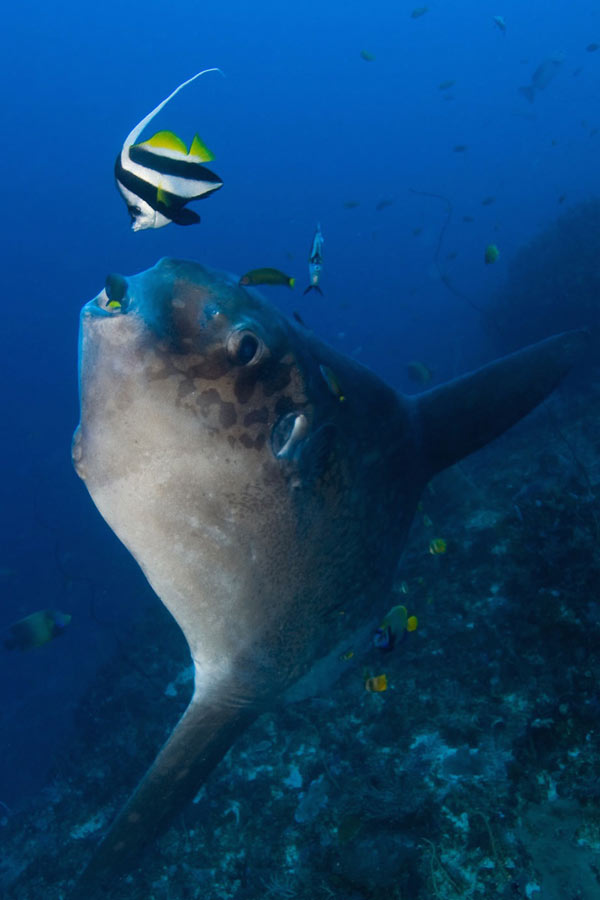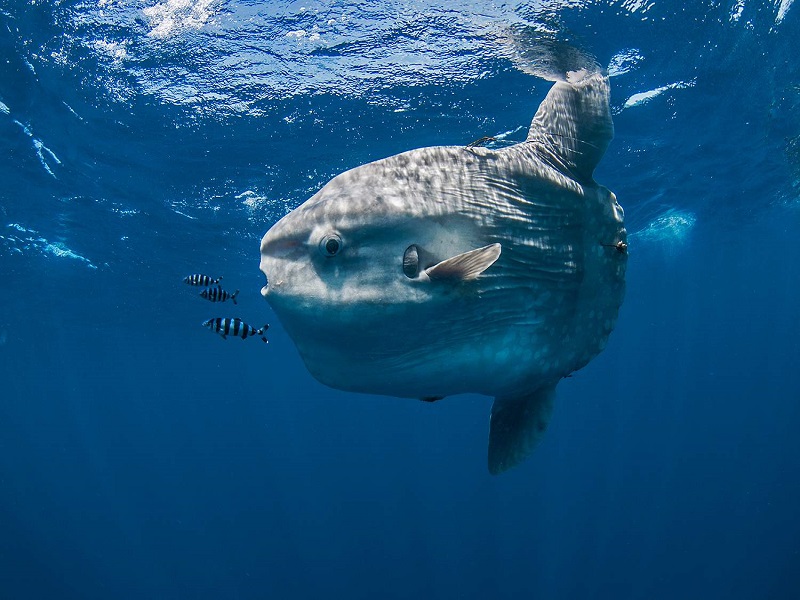One of the most strange aquatic visitors to Bali has to be the Mola Mola or Sunfish as it’s often referred to; a name it got because of its habit of floating at the surface with its side facing the sun, almost as if it were sunbathing. It’s a remarkable species often spotted around Nusa Penida, Bali. These gentle giants can reach impressive sizes, with the largest recorded weighing a staggering 6,049 pounds (about 2,743 kg).

What is a Mola Mola?
The Mola Mola is the heaviest bony fish in the world. With a peculiar shape, it’s characterized by a round, flattened body and a truncated tail. It kind of reminds me of a huge dinner plate, although they more closely resemble an entire table! Despite its slow pace, this fish navigates most of the world’s oceans and can dive deep for protection and feeding.
Species Anatomy
Sunfish have a tank-like body with a clavus, a scalloped fin used as a rudder, replacing the typical fish’s tail fin. Its body is scaleless, covered with thick elastic skin, and it has small pectoral fins. Its teeth are fused into a beak-like structure, essential for its unique diet.
What Do They Eat?
Their diet mainly consists of gelatinous organisms like jellies, ctenophores, and zooplankton. To break down this food, they suck the prey in and out through its small mouth, reducing it to gelatinous chunks, or what one might call “ocean jello.” This slow process helps the fish consume its preferred prey without chewing.
How Big Are Sunfish?
Molas can grow up to 10 feet long and over 14 feet tall, measuring from the tip of the dorsal fin to the anal fin. The largest recorded can weigh as much as a pickup truck, with some reaching up to 2.3 tons.

Where is the Best Place to See Mola Mola?
Nusa Penida is filled with amazing marine life. It is one of the best places in the world to spot the sunfish, particularly around dive sites such as Crystal Bay and Manta Point. Also home to Bali’s famous manta rays so if you’re lucky you will get to see them both at once!
Although they are a bit shy, they often cruise by to say hello during their prime season. The waters around these dive sites are rich with the marine life that supports the mola, making it an ideal destination for divers. They are frequently seen at the cleaning stations or just passing through on their way back to the depths.
How Deep is the Mola Mola in Bali?
Divers typically find Mola Mola at depths of 20 to 70 meters in Bali waters but they have been recorded as deep as 1,515 meters. Divers can spot these creatures at shallower depths when they come up to be cleaned by smaller fish. Recently, a group of divers on their way to Manta Point saw and snorkeled with a Mola at the surface. Stories of these huge fish breaching and leaping into the air have been heard more than once, likely as an attempt to rid themselves of parasites.
When Can I See Mola Mola in Bali, Indonesia?
They can be seen in Bali during specific times of the year when the waters are cool and rich with plankton.
Mola Mola Season in Bali
The prime season for sightings is from July to October when the ocean temperatures drop to their ideal range. During this period, the Molas come up from deeper waters, providing a rare chance for divers to interact with them.
Off-Season Sightings?
While the best time is during the cooler months, occasional sightings can still happen outside the typical season. However, these are rarer and less predictable.
How Can I See a Mola Mola While Diving?
To increase your chances of seeing a Mola Mola while diving, head to Nusa Penida during the peak season. Be sure to dive at well-known hotspots like Crystal Bay and opt for guided dives with experienced dive operators who are familiar with marine habits and locations.
What to Keep in Mind When Diving with Mola Mola
It is best to keep your distance, for your own safety and theirs! Pursuing the sunfish to try and get that ‘perfect shot’ often results in the fish disappearing back into the depths. The ocean is vast—give them space.
Also, ensure you do not touch them. Touching them could remove their protective coating, causing immense pain, similar to third-degree burns, and potentially resulting in the fish’s death.
Molas are majestic, albeit odd-looking, and are best viewed from a calm and respectful distance. Quite often, they are curious and will swim toward you, playing in your exhaled bubbles. It is up to all of us as divers to treat the underwater realm with respect! Remember to take only pictures and leave only bubbles.
So next time you’re in Bali make sure you head to out to see these truly magnificent fish. With their “chill” nature and slow glide through the ocean you’ll be sure to catch a good look at these famous creatures! If you’re curious about other less common species to check out in Bali, take a look at our sharks in Bali blog that talks about these much less seen, underwater beasts!




